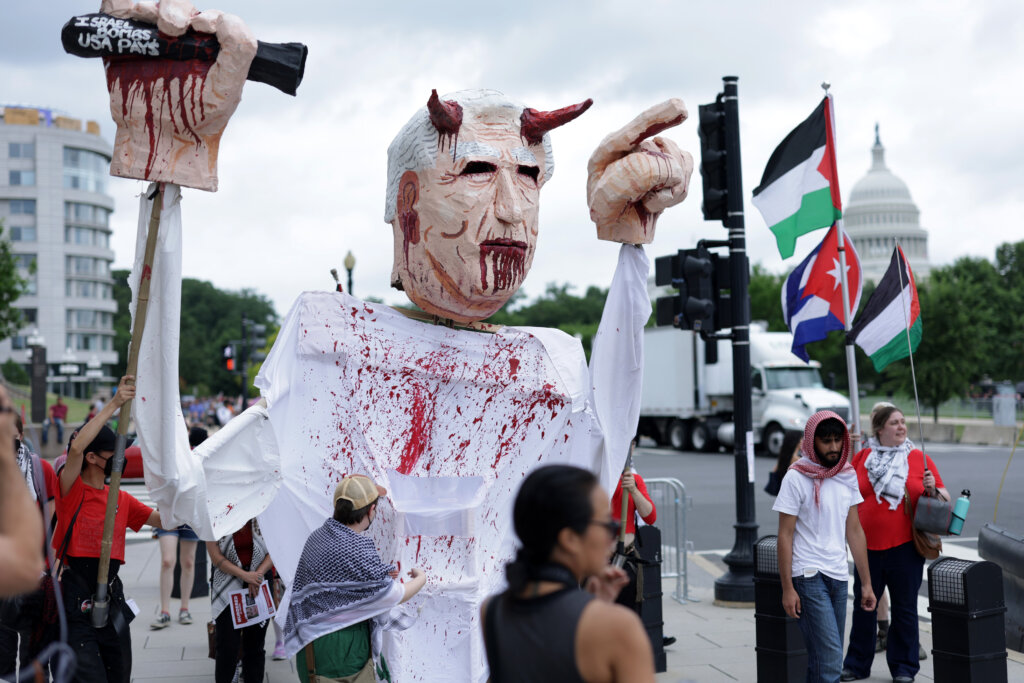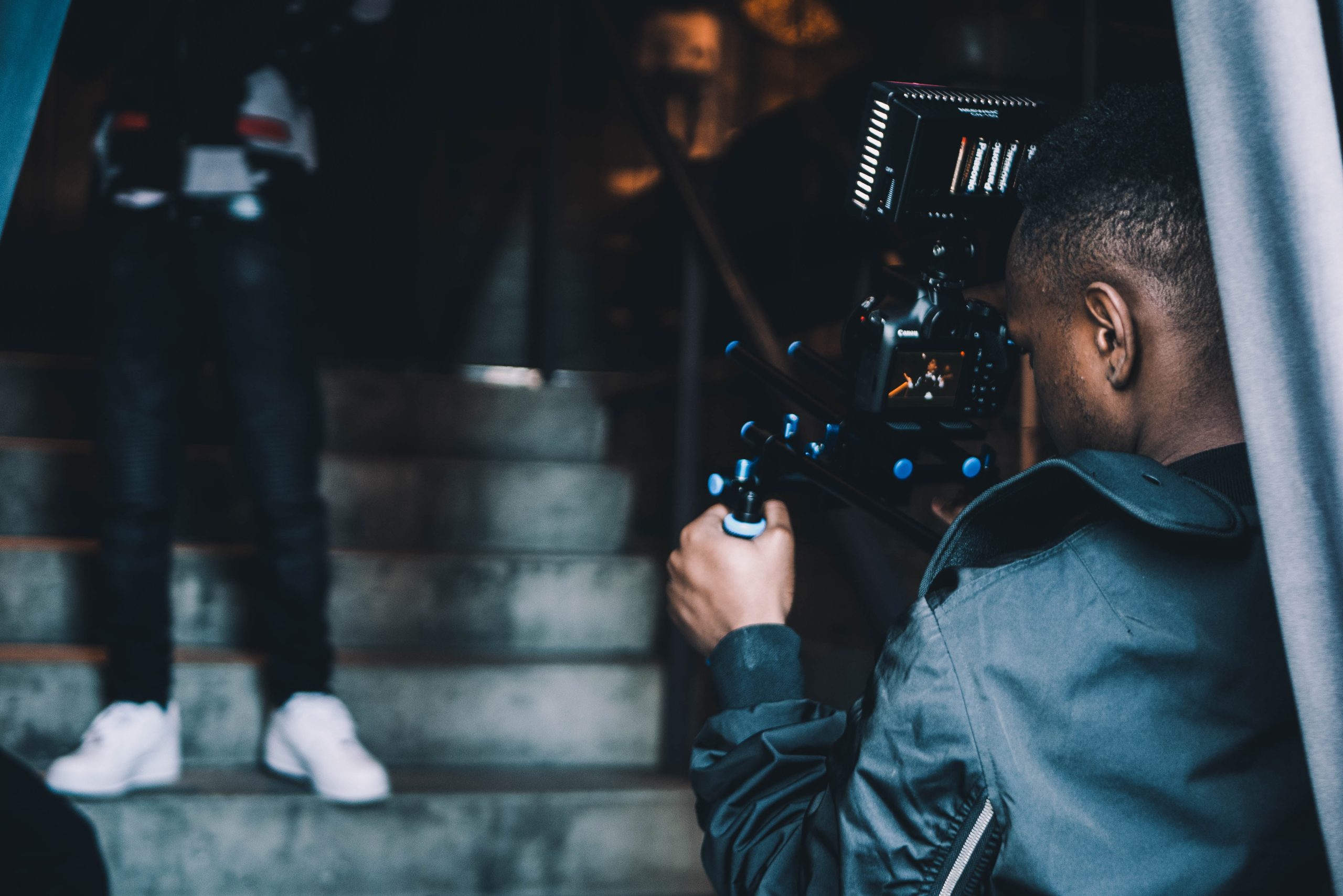Pro-Palestinian protesters spray paint a message outside the Capitol. Courtesy of Getty Images
Outside the Capitol in Washington, pro-Palestinian protesters on Wednesday splashed a message in red spray paint across the plinth of a statue at Washington D.C.’s Union Station: “Hamas is coming.”
Positive sentiments toward Hamas, which the United States has considered a terrorist organization since 1997, have been part of some of the most extreme wings of the protest movement against Israel since Hamas attacked it on Oct. 7. But the spray-painted message came at a prominent moment, lending credence to the caricatures the pro-Israel right has painted of pro-Palestinian protesters and triggering condemnation from the presumptive Democratic presidential nominee.
Indeed, the object of Wednesday’s protest, Israeli Prime Minister Benjamin Netanyahu, was at the very same time decrying all pro-Palestinian activists as aligning themselves with terrorists in a conflict he described as between civilization and barbarism. “Many choose to stand with evil,” Netanyahu said in his address to a joint session of Congress. “They stand with Hamas.”
Netanyahu was echoing a legion of pro-Israel talking heads who have since the earliest days after Oct. 7 labeled virtually all such protests “pro-Hamas” instead of “pro-Palestinian. ” In fact, placards praising Hamas or activists wearing its signature green have been largely hidden and far outweighed by kaffiyehs, the black-and-white checked scarves seen as a symbol of the Palestinian national movement, and chants like “from the river to the sea, Palestine will be free.”
While support for Palestinians has grown since the outbreak of the war in Gaza, Hamas remains unpopular. A poll from the Pew Research Center in March found that while 50% of Americans view the Palestinian people favorably, only 8% view Hamas in a positive light.
On Wednesday, too, open celebration of Hamas was dwarfed among the 5,000-some protesters who filled the National Mall by criticism of Netanyahu’s prosecution of the war and American funding of Israel. But the “Hamas is Coming” graffiti and other pro-Hamas sentiment, however small a percentage of the protest it was, still caught the most attention.
Vice President Kamala Harris was among the public figures condemning it, and the burning of an American flag at the protest,, issuing a statement that lambasted “unpatriotic rhetoric and dangerous hate-fueled rhetoric.”
“I condemn any individuals associating with the brutal terrorist organization Hamas, which has vowed to annihilate the State of Israel and kill Jews,” she wrote. “Pro-Hamas graffiti and rhetoric is abhorrent and we must not tolerate it in our nation.”
Alongside the spray-painted flagpole at Union Station, some protesters carried signs that suggested support for its brutal assault on Israel, including claims that all resistance against Israeli occupation is justified. One sign invoked Iran reading “From Iran to Palestine: Women, Life, Freedom,” while another said “Stand with Hamas,” with an image of the Israeli flag crossed out. A few people carried the green, Arabic-inscribed Hamas flag.

But as has been the case at most demonstrations against the Gaza war, including the encampments on college campuses this spring, most of the signs took a different tack.
“Wanted: Benjamin Netanyahu, war criminal,” read hundreds of placards. “End All U.S. Aid to Israel: Stop the Genocide” said hundreds more.
Many Jews online framed the open invocation of Hamas-led violence, alongside the burning of American and Israeli flags — and effigies of Netanyahu — as a clear shift or escalation among the protests. But “Hamas is coming” is not an entirely new slogan — it’s just that the threat has previously been made by the other side, a common refrain among pro-Israel groups.
“Let’s be clear: Hamas is your problem too,” said billboards placed by the pro-Israel advocacy group JewBelong across the country over the past several months. Its social media page continues the warning: “You know who comes right after Jews on Hamas’s hit list? Everyone else,” says one post. “Dear Americans, watch your back,” says another, signing the message from “Hamas.”
Netanyahu made a similar threat during his speech on Wednesday, saying that Israel was the only thing standing between Iran — which financially and politically backs Hamas as well as Hezbollah and the Houthis in Yemen — and the U.S. “The main war, the real war, is with America,” he said.

The threats made by each bloc of protesters are surprisingly parallel, though of course the imagined route to their actualization is different.
Netanyahu wants to decisively win the war in Gaza, ending Hamas rule there and demilitarizing the territory as Germany and Japan were “demilitarized and deradicalized” after World War II. The protesters want the war to end with Netanyahu being tried for war crimes and, depending which group of protesters you ask, Israel becoming a binational or fully Palestinian state. But each warns that if their demands aren’t met, an Iran-backed war will come to American shores.
This threat, however violent sounding, seems far-fetched; Hamas military capabilities have been heavily diminished by the Israeli barrage, and the U.S. is a global superpower. Perhaps more concerning is the antisemitic symbolism that infiltrated Wednesday’s protest imagery. A giant effigy of a horned Netanyahu was carried through the streets of D.C., evoking concerning antisemitic stereotypes about devilish Jews. Numerous other signs characterized the Jewish group AIPAC as controlling the government.
A Hamas attack may be unlikely; growing American antisemitism, on the other hand, is easy to see.

We’re building on 127 years of independent journalism to help you develop deeper connections to what it means to be Jewish today.
With so much at stake for the Jewish people right now — war, rising antisemitism, a high-stakes U.S. presidential election — American Jews depend on the Forward’s perspective, integrity and courage.
— Jodi Rudoren, Editor-in-Chief























